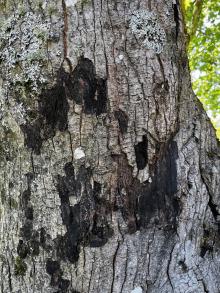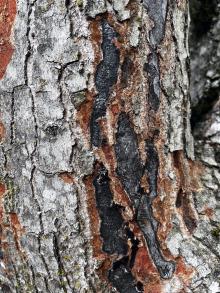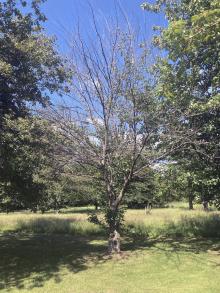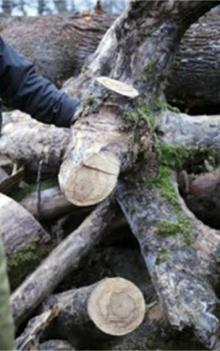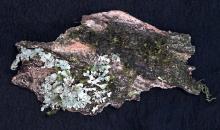Cause The fungus Cryptostroma corticale has been causing dieback primarily in sycamore maples (Acer pseudoplatanus), although several other species can also become infected. The disease was found in eastern WA in 1968 and in the Seattle area in 2020 on sycamore maple, red maple (Acer rubrum), Japanese maple (A. palmatum), vine maple (A. circinatum) and big leaf maple (A. macrophyllum). Pacific dogwood (Cornus nuttallii) and horsechestnut (Aesculus hippocastanum) have been confirmed as hosts in the Pacific Northwest. In Oregon, the pathogen was found in Bend on Norway maple (Acer platanoides), and Freeman maple (Acer x freemanii), and on vine maple (Acer circinatum) in the Portland area.
The fungus is thought to infect and kill small, inconspicuous branches, then spreads into the heartwood where it continues to proliferate up and down the tree. Pruning wounds may also be infected. The rate of growth of the fungus is greater at higher temperatures and is more rapid in an infected tree when the summers are hot. The fungus can grow quickly within the tree if it has been stressed by drought, particularly if multiple years of water stress have occurred. With high temperatures, the fungus grows rapidly from the center of the tree out toward the bark. The fungus kills the bark, causing it to blister. Dark gray masses that blacken with age, stromata, are formed pushing up the bark. These stomata resemble soot, hence the name sooty bark disease. Once spores are dispersed by wind, the remaining tissue beneath them looks black. Some trees may be infected but show no outward symptoms.
The disease is not found in coastal or high elevation areas of Germany that are cooler and rainier than other areas.
Rarely, the spores may cause a severe reaction in susceptible people, which has been a problem for those working around diseased maples, such as arborists and loggers. In humans it is called maple bark disease causing a hypersensitive pneumonitis with symptoms similar to COPD.
Rarely, the spores may cause a severe reaction in susceptible people, which has been a problem for those working with diseased maples, such as mill workers. In humans, this hypersensitive pneumonitis is caused by inhaling spores of the pathogen and is referred to as maple bark disease.
Symptoms An infected tree may have numerous small dead twigs that line up one side of the trunk, or small cankers on the trunk. Heavily infected trees may have leaves that wilt over part or all of the canopy. Epicormic shoots may also be produced. Canopy and branch dieback is common in infected trees. Symptoms may only be observed on a single branch in trees with multiple stems. Tree mortality soon follows after signs of the disease appear, but some trees remain alive for many years.
In confirmed hosts, sooty bark disease can be diagnosed based on signs of infection. Spore production in the bark periderm just under the epidermis results in bark blisters. The bark cracks or sloughs away exposing dark patches of the dark brown to black fungal stroma and powdery black spores. These patches are often oblong and parallel to the stem and occur on dead or dying portions of the tree. Upon closer inspection, these patches are sunken into the bark (with the top layer of bark flaked off). These signs can fade or turn lighter over time. Trees may have a black or greenish-brown-to-greenish-yellow stain of the wood (soft rot) that can be seen when an infected branch is cut into cross-section. This soft rot is due to lignin degradation and can go into the roots. The staining is in a single column, not streaky, as occurs with Verticillium wilt.
May be confused with other pathogens. Stegonsporium pyriforme (also found on big leaf maple in WA) produces smaller black spots rather than a black layer. Kretzschmaria deusta, brittle cinder fungus, produces thick, rough, and lumpy fruiting bodies on the surface of the bark or wood, usually near ground level.
Cultural control Arborists and wood workers should wear PPE to avoid inhaling spores, keep spores out of their eyes and respiratory system when removing or working with infected trees.
- Scout landscapes, parks, and street trees for incidences of this disease. Early detection will aid in overall control.
- Remove, cover during transport and burn infected trees. Removal during rainy months is suggested.
- Do not transport or save for firewood.
- Do not prune healthy trees in the dry summer months.
References Braun, M., Klingelhöfer, D. and Groneberg, D. A., 2021. Sooty bark disease of maples: the risk for hypersensitivity pneumonitis by fungal spores not only for woodman. Journal of Occupational Medicine and Toxicology, 16:1-7.
Brooks, R. K., Omdal, D., Brown, S., Marshall, C. J., Hulbert, J. M., Elliott, M. and Chastagner, G. 2023. Cryptostroma corticale, the causal agent of sooty bark disease of maple, appears widespread in western Washington State, USA. Forest Pathology, p.e12835. 53:e12835. https://doi.org/10.1111/efp.12835


